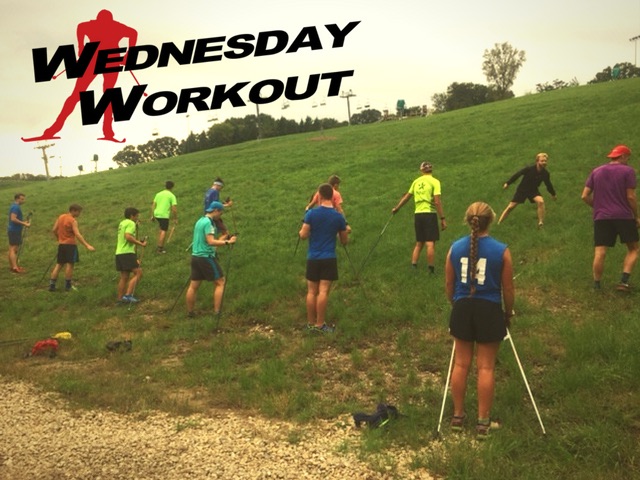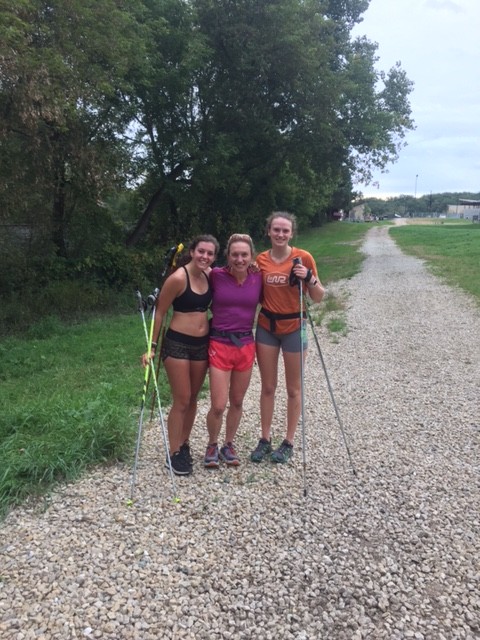
This workout is based on one described by Caitlin Gregg in 2013: “I absolutely love doing hard intervals (Level 4) from 3-5 minutes in length, over and over again, sometimes feeling invincible and sometimes feeling like I am going to pass out!”
She described working with Piotr Bednarski’s Loppet Nordic Racing (LNR) training group in Minneapolis/St. Paul, Minnesota, and beginning a session by doing core work and ski walking. That led into plyometric jumps and finally hard running up a hill for roughly three minutes, repeated three to eight times.

This time around, Gregg has some additional advice: how to use such a workout to get the very most out of your local training grounds. What if you need to train hills, but live where it’s flat? Even a small hill can make for a big workout.
“We typically spend one day a week doing intensity on foot with LNR,” Gregg writes. “The intensity alternates between L-3 running intervals on rolling terrain and L-4+ Moosehoofing and bounding intervals on steep terrain. With only 175 feet of possible elevation gain within the Twin Cities limits, we had to get creative about how to get in enough distance to make the intervals 3:30 – 5 mins each.”
You can find those 175 feet at the Hyland Hills Ski Area, usually home to alpine skiers and snowboarders. So LNR, Gregg, and other area cross-country skiers head there in the summer and skip the terrain park in favor of going uphill, as hard as possible.
“We climb up the far the right side of the alpine area on the service road which is the perfect pitch for hard moosehoofs or bounding with poles and takes about 1:45 to reach the peak,” Gregg explains. “Once on top we lift our poles and enter a high turnover slightly downhill full-out run across the ‘ridge.’ We get about 3/4’s of the way across the top before we drop down a steep 50ft. section before hitting the final climb as moosehoofs or bounding with our poles again. The last climb lasting is about 1:00 to the summit and hurts a lot!”
The Workout:
Warm up: 20-minute jog and mobility exercises
Part I:
– Intense core work (i.e. medicine ball throws, weighted incline bench sit-ups, isometric holds, partner throws)
– Ski walking up alpine hill
Part II:
– Plyometric jumps up the hill (with medicine balls for added resistance):
8-10 sets per side, 100 percent effort with rest in between: side skate jumps, cross-over glute leaps, broad jumps, 20-seconds all-out bounding with poles.
Part III:
– Run from base to top of hill or mountain (aim for about 3 minutes 30 seconds), then jog down (about 3 minutes back to start). Repeat 3-4 or 6-8 times.
Cool down: 20-30 minutes
While the climb doesn’t exactly represent three minutes of dedicated climbing, Gregg says that’s okay. In most ski races, you wouldn’t encounter three minutes of sustained climbing at the same pitch with the same technique anyway.
“Although the terrain limits our ability to continuously climb for 3:30- 5 mins, I find that the need to change gears and speeds and technique is more like what we would find in a race during the winter,” she explained.

Like any interval workout, the goal is for consistency over time.
“I strive to get under 3:30 for each interval and be able to hold the same pace for the entire workout. Some people get 3-4 in and some get 6-8. It all depends on each person’s fitness level and how they are feeling. The best part is everyone suffers together,” she wrote back in 2013.
“After the intensity is over everyone jogs a cool down for about 20-30 minutes and spends some time chatting while stretching in the parking lot… I usually have someone who can push me for each individual segment, which makes the workout fun and super high quality at the same time. I also think it is pretty cool for the other participants to train along side an Olympian and see how I approach the same workout they are doing! I have been joining Piotr for this workout for the past 9 years and I have never been disappointed in the results!”
Chelsea Little
Chelsea Little is FasterSkier's Editor-At-Large. A former racer at Ford Sayre, Dartmouth College and the Craftsbury Green Racing Project, she is a PhD candidate in aquatic ecology in the @Altermatt_lab at Eawag, the Swiss Federal Institute of Aquatic Science and Technology in Zurich, Switzerland. You can follow her on twitter @ChelskiLittle.



